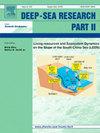Coral reefs health status variation around Kish Island before and after 2015 bleaching in the Persian Gulf: A case study of global warming effects
IF 3
3区 地球科学
Q2 OCEANOGRAPHY
Deep-sea Research Part Ii-topical Studies in Oceanography
Pub Date : 2025-04-28
DOI:10.1016/j.dsr2.2025.105484
引用次数: 0
Abstract
Despite the ecological importance of coral reefs in the Persian Gulf as one of the most sensitive and fragile marine ecosystems in this region, few ecological studies have been carried out in this area. The aims of the present study were to evaluate the species diversity of corals and cohabiting fishes, produce a health status assessment of hard corals in two different periods (2014 and 2020), identify the main destructive factors, and create a distribution map for coral reefs around Kish Island. During this survey, the density and percentage of live and dead corals were evaluated and compared in two periods. Cover percentage of live, bleached, and dead hard corals changed significantly from 2014 to 2020, and in most sites, biological communities are negatively affected. The situation is highly concerning for fishes that were examined as biological indicators of living conditions in the coral communities. Comparing 2014 and 2020 data, about half of fish species were not detected or rarely observed in 2020. Heat anomalies, fishing activities, and overtourism were found to be the most destructive factors on the coral reefs in Kish Island.
2015年前后波斯湾基什岛周围珊瑚礁健康状况的变化:全球变暖影响的案例研究
尽管波斯湾的珊瑚礁是该地区最敏感和脆弱的海洋生态系统之一,具有重要的生态意义,但在该地区开展的生态学研究很少。本研究的目的是评估珊瑚和同居鱼类的物种多样性,对2014年和2020年两个不同时期的硬珊瑚进行健康状况评估,确定主要破坏因素,并绘制基什岛周围珊瑚礁分布图。在调查期间,我们分两个阶段评估和比较活珊瑚和死珊瑚的密度和百分比。从2014年到2020年,活珊瑚、白化珊瑚和死珊瑚的覆盖比例发生了显著变化,在大多数地点,生物群落受到了负面影响。这种情况对作为珊瑚群落生活条件的生物指标而加以检查的鱼类来说是非常令人关切的。比较2014年和2020年的数据,2020年大约有一半的鱼类没有被检测到或很少被观察到。温度异常、捕捞活动和过度旅游是基什岛珊瑚礁最具破坏性的因素。
本文章由计算机程序翻译,如有差异,请以英文原文为准。
求助全文
约1分钟内获得全文
求助全文
来源期刊
CiteScore
6.40
自引率
16.70%
发文量
115
审稿时长
3 months
期刊介绍:
Deep-Sea Research Part II: Topical Studies in Oceanography publishes topical issues from the many international and interdisciplinary projects which are undertaken in oceanography. Besides these special issues from projects, the journal publishes collections of papers presented at conferences. The special issues regularly have electronic annexes of non-text material (numerical data, images, images, video, etc.) which are published with the special issues in ScienceDirect. Deep-Sea Research Part II was split off as a separate journal devoted to topical issues in 1993. Its companion journal Deep-Sea Research Part I: Oceanographic Research Papers, publishes the regular research papers in this area.

 求助内容:
求助内容: 应助结果提醒方式:
应助结果提醒方式:


